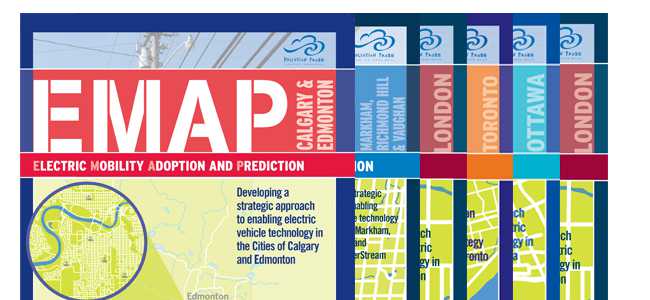Lead Proponent: The Pollution Probe Foundation
Location: Toronto, Ontario
ecoEII Contribution: $ 1,025,125
Project Total: $ $ 1,557,625
Project Background:
The electrification of transportation is one of the most effective strategies for achieving a sustainable transportation sector in Canada. The lack of research on the ability of local electricity grids to accommodate increasing numbers of electric vehicles (EVs), and the need for stakeholders to collaborate, are unique challenges that must be addressed to ensure successful integration and adoption of EVs. Recognizing these challenges, Pollution Probe proposed the concept of an Electric Mobility Adoption and Prediction (EMAP) methodology – a tool of predictive analysis. EMAP would combine market research and demand analysis with detailed electricity grid integration impact analysis, to determine whether local utility grids are capable of providing charge for significant numbers of EVs without exceeding the capacity of distribution transformers. Pollution Probe applied for funding from ecoEII, and was awarded $1,025M to develop EMAP. Electric Mobility Canada, and the five partnering utility companies, also provided financial and technical support.
Results:
Five local utility companies, servicing a total of nine major Canadian municipalities, participated and contributed to the development of EMAP. They were: Hydro Ottawa (Ottawa), Horizon Utilities (Hamilton and St. Catharines), London Hydro (London), and PowerStream (Markham, Richmond Hill and Vaughan) in Ontario, and ENMAX Corporation (Calgary and Edmonton) in Alberta. Pollution Probe partnered with Environics Research Group and Environics Analytics to conduct market research and demand analysis in each of the utility service areas. This included secondary research to identify the geographic distribution of potential early adopters of EV technology and primary research to validate and characterize early adopter neighbourhoods. Knowledge and data were acquired on the demographics of early adopters, their motivations for purchasing an EV, vehicle usage, range and charge patterns, as well as barriers to adoption.
To better understand the impact of anticipated uptake of EVs on the local distribution systems, scenario development and simulations were undertaken to assess the electricity distribution system’s capacity to support additional loads resulting from EV charging while maintaining grid stability. The process involved two separate but related investigations:
- A neighbourhood-level assessment of the distribution system, beginning with the pole or pad mounted transformers and ending with the secondary cables that provide electricity to individual homes. The impacts of EV charging on the distribution system were simulated using data provided by partnering utilities.
- A system-wide examination of the potential impact of EVs on the distribution systems of participating municipalities were conducted by their respective utilities, with a focus on neighbourhoods identified through market research as early adopter hot-spots.
A comprehensive final report was produced for each partnering utility and is available for download on Pollution Probe’s website (http://www.pollutionprobe.org/ ). Each EMAP report combines statistically significant, neighbourhood-specific EV adoption projections with neighbourhood-scale grid integration and impact analysis.
Benefits to Canada:
The data collected, along with the tools and methodologies developed, will support and inform EV and electricity system stakeholders across Canada as they adapt and plan for a future in which EVs are increasingly integrated into society. Moreover, collaboration fostered between utilities and other stakeholders will assist in strategic planning and successful deployment of EVs in Canada.
Next Steps:
There is great potential for implementation of the EMAP methodology in other jurisdictions across Canada. Working with municipal governments and local utilities, Pollution Probe will adapt the EMAP tool and apply lessons learned over the course of the project to develop and promote EV implementation strategies for the future.
